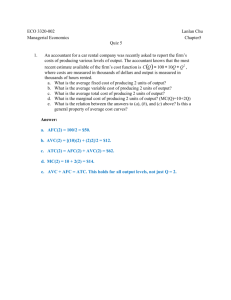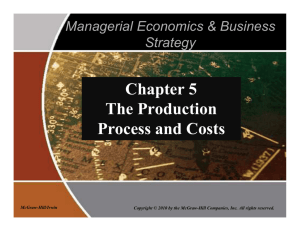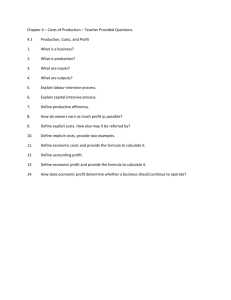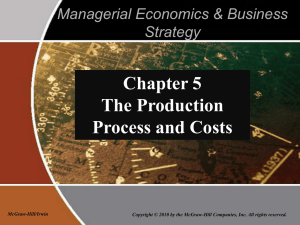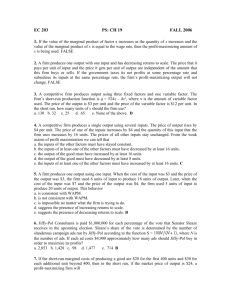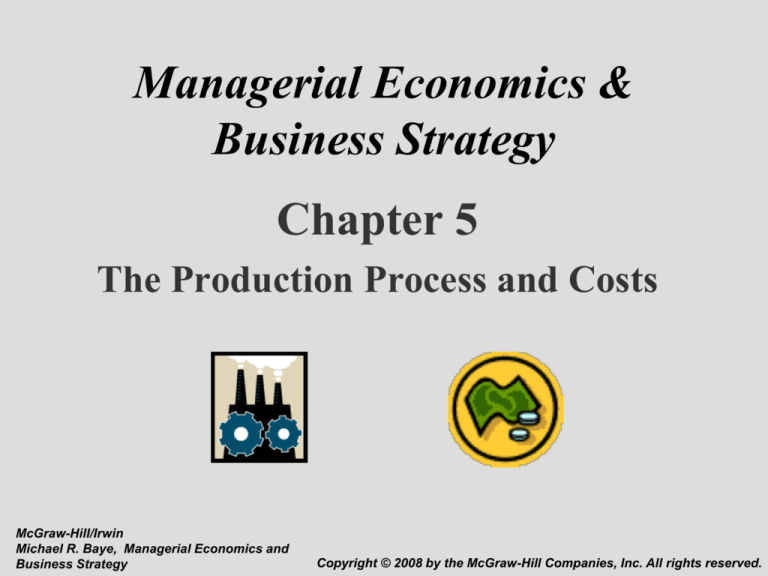
Managerial Economics &
Business Strategy
Chapter 5
The Production Process and Costs
McGraw-Hill/Irwin
Michael R. Baye, Managerial Economics and
Business Strategy
Copyright © 2008 by the McGraw-Hill Companies, Inc. All rights reserved.
5-2
Overview
I. Production Analysis
Total Product, Marginal Product, Average Product
Isoquants
Isocosts
Cost Minimization
II. Cost Analysis
Total Cost, Variable Cost, Fixed Costs
Cubic Cost Function
Cost Relations
III. Multi-Product Cost Functions
5-3
Production Analysis
• Production Function
Q = F(K,L)
•
•
•
•
Q is quantity of output produced.
K is capital input.
L is labor input.
F is a functional form relating the inputs to output.
The maximum amount of output that can be produced
with K units of capital and L units of labor.
• Short-Run vs. Long-Run Decisions
• Fixed vs. Variable Inputs
5-4
Production Function Algebraic
Forms
• Linear production function: inputs are perfect
substitutes.
Q F K , L aK bL
• Leontief production function: inputs are used in
fixed proportions.
Q F K , L min bK , cL
• Cobb-Douglas production function: inputs have a
degree of substitutability.
Q F K , L K L
a b
5-5
Productivity Measures:
Total Product
• Total Product (TP): maximum output produced
with given amounts of inputs.
• Example: Cobb-Douglas Production Function:
Q = F(K,L) = K.5 L.5
K is fixed at 16 units.
Short run Cobb-Douglass production function:
Q = (16).5 L.5 = 4 L.5
Total Product when 100 units of labor are used?
Q = 4 (100).5 = 4(10) = 40 units
5-6
Productivity Measures: Average
Product of an Input
• Average Product of an Input: measure of output
produced per unit of input.
Average Product of Labor: APL = Q/L.
• Measures the output of an “average” worker.
• Example: Q = F(K,L) = K.5 L.5
– If the inputs are K = 16 and L = 16, then the average product of
labor is APL = [(16) 0.5(16)0.5]/16 = 1.
Average Product of Capital: APK = Q/K.
• Measures the output of an “average” unit of capital.
• Example: Q = F(K,L) = K.5 L.5
– If the inputs are K = 16 and L = 16, then the average product of
capital is APK = [(16)0.5(16)0.5]/16 = 1.
Productivity Measures: Marginal
Product of an Input
• Marginal Product on an Input: change in total
output attributable to the last unit of an input.
Marginal Product of Labor: MPL = DQ/DL
• Measures the output produced by the last worker.
• Slope of the short-run production function (with respect to
labor).
Marginal Product of Capital: MPK = DQ/DK
• Measures the output produced by the last unit of capital.
• When capital is allowed to vary in the short run, MPK is the
slope of the production function (with respect to capital).
5-7
Increasing, Diminishing and
Negative Marginal Returns
Q
Increasing
Marginal
Returns
Diminishing
Marginal
Returns
Negative
Marginal
Returns
Q=F(K,L)
MP
AP
L
5-8
5-9
Guiding the Production Process
• Producing on the production function
Aligning incentives to induce maximum worker effort.
• Employing the right level of inputs
When labor or capital vary in the short run, to
maximize profit a manager will hire
• labor until the value of marginal product of labor equals
the wage: VMPL = w, where VMPL = P x MPL.
• capital until the value of marginal product of capital
equals the rental rate: VMPK = r, where VMPK = P x
MPK .
5-10
Isoquant
• Illustrates the long-run combinations of
inputs (K, L) that yield the producer the
same level of output.
• The shape of an isoquant reflects the ease
with which a producer can substitute
among inputs while maintaining the same
level of output.
5-11
Marginal Rate of Technical
Substitution (MRTS)
• The rate at which two inputs are substituted
while maintaining the same output level.
MRTS KL
MPL
MPK
5-12
Linear Isoquants
• Capital and labor are
perfect substitutes
Q = aK + bL
MRTSKL = b/a
Linear isoquants imply that
inputs are substituted at a
constant rate, independent
of the input levels
employed.
K
Increasing
Output
Q1
Q2
Q3
L
5-13
Leontief Isoquants
• Capital and labor are perfect
complements.
• Capital and labor are used in
fixed-proportions.
• Q = min {bK, cL}
• Since capital and labor are
consumed in fixed
proportions there is no input
substitution along isoquants
(hence, no MRTSKL).
Q3
K
Q2
Q1
Increasing
Output
L
5-14
Cobb-Douglas Isoquants
• Inputs are not perfectly
substitutable.
• Diminishing marginal rate
of technical substitution.
K
Q3
Q2
Q1
Increasing
Output
As less of one input is used in
the production process,
increasingly more of the other
input must be employed to
produce the same output level.
• Q = KaLb
• MRTSKL = MPL/MPK
L
5-15
Isocost
• The combinations of inputs that K
produce a given level of output
C1/r
at the same cost:
C0/r
wL + rK = C
• Rearranging,
K= (1/r)C - (w/r)L
• For given input prices, isocosts K
farther from the origin are
C/r
associated with higher costs.
• Changes in input prices change
the slope of the isocost line.
New Isocost Line
associated with higher
costs (C0 < C1).
C0
C0/w
C1
C1/w
L
New Isocost Line for
a decrease in the
wage (price of labor:
w0 > w1).
C/w0
C/w1
L
5-16
Cost Minimization
• Marginal product per dollar spent should be
equal for all inputs:
MPL MPK
MPL w
w
r
MPK r
• But, this is just
MRTS KL
w
r
5-17
Cost Minimization
K
Slope of Isocost
=
Slope of Isoquant
Point of Cost
Minimization
Q
L
5-18
Optimal Input Substitution
• A firm initially produces Q0
by employing the
combination of inputs
represented by point A at a
cost of C0.
• Suppose w0 falls to w1.
The isocost curve rotates
counterclockwise; which
represents the same cost level
prior to the wage change.
To produce the same level of
output, Q0, the firm will
produce on a lower isocost line
(C1) at a point B.
The slope of the new isocost
line represents the lower wage
relative to the rental rate of
capital.
K
A
K0
B
K1
Q0
0 L0
L1 C0/w0
C1/w1
C0/w1 L
5-19
Cost Analysis
• Types of Costs
Short-Run
• Fixed costs (FC)
• Sunk costs
• Short-run variable
costs (VC)
• Short-run total costs
(TC)
Long-Run
• All costs are variable
• No fixed costs
5-20
Total and Variable Costs
C(Q): Minimum total cost $
of producing alternative
levels of output:
C(Q) = VC + FC
VC(Q)
C(Q) = VC(Q) + FC
VC(Q): Costs that vary
with output.
FC: Costs that do not vary
with output.
FC
0
Q
5-21
Fixed and Sunk Costs
FC: Costs that do not change $
as output changes.
Sunk Cost: A cost that is
forever lost after it has been
paid.
Decision makers should
ignore sunk costs to
maximize profit or minimize
losses
C(Q) = VC + FC
VC(Q)
FC
Q
5-22
Some Definitions
Average Total Cost
ATC = AVC + AFC
ATC = C(Q)/Q
$
MC
ATC
AVC
Average Variable Cost
AVC = VC(Q)/Q
MR
Average Fixed Cost
AFC = FC/Q
Marginal Cost
MC = DC/DQ
AFC
Q
5-23
Fixed Cost
Q0(ATC-AVC)
$
= Q0 AFC
= Q0(FC/ Q0)
MC
ATC
AVC
= FC
ATC
AFC
Fixed Cost
AVC
Q0
Q
5-24
Variable Cost
$
Q0AVC
MC
ATC
= Q0[VC(Q0)/ Q0]
AVC
= VC(Q0)
AVC
Variable Cost
Minimum of AVC
Q0
Q
5-25
Total Cost
Q0ATC
$
= Q0[C(Q0)/ Q0]
= C(Q0)
MC
ATC
AVC
ATC
Minimum of ATC
Total Cost
Q0
Q
5-26
Cubic Cost Function
• C(Q) = f + a Q + b Q2 + cQ3
• Marginal Cost?
Memorize:
MC(Q) = a + 2bQ + 3cQ2
Calculus:
dC/dQ = a + 2bQ + 3cQ2
5-27
An Example
Total Cost: C(Q) = 10 + Q + Q2
Variable cost function:
VC(Q) = Q + Q2
Variable cost of producing 2 units:
VC(2) = 2 + (2)2 = 6
Fixed costs:
FC = 10
Marginal cost function:
MC(Q) = 1 + 2Q
Marginal cost of producing 2 units:
MC(2) = 1 + 2(2) = 5
5-28
Long-Run Average Costs
$
LRAC
Economies
of Scale
Diseconomies
of Scale
Q*
Q
5-29
Multi-Product Cost Function
• C(Q1, Q2): Cost of jointly producing two
outputs.
• General function form:
C Q1 , Q2 f aQ1Q2 bQ cQ
2
1
2
2
5-30
Economies of Scope
• C(Q1, 0) + C(0, Q2) > C(Q1, Q2).
It is cheaper to produce the two outputs jointly instead
of separately.
• Example:
It is cheaper for Time-Warner to produce Internet
connections and Instant Messaging services jointly than
separately.
5-31
Cost Complementarity
• The marginal cost of producing good 1
declines as more of good two is produced:
DMC1Q1,Q2) /DQ2 < 0.
• Example:
Cow hides and steaks.
Quadratic Multi-Product Cost
Function
•
•
•
•
•
C(Q1, Q2) = f + aQ1Q2 + (Q1 )2 + (Q2 )2
MC1(Q1, Q2) = aQ2 + 2Q1
MC2(Q1, Q2) = aQ1 + 2Q2
Cost complementarity: a < 0
Economies of scope:
f > aQ1Q2
C(Q1 ,0) + C(0, Q2 ) = f + (Q1 )2 + f + (Q2)2
C(Q1, Q2) = f + aQ1Q2 + (Q1 )2 + (Q2 )2
f > aQ1Q2: Joint production is cheaper
5-32
5-33
A Numerical Example:
• C(Q1, Q2) = 90 - 2Q1Q2 + (Q1 )2 + (Q2 )2
• Cost Complementarity?
Yes, since a = -2 < 0
MC1(Q1, Q2) = -2Q2 + 2Q1
• Economies of Scope?
Yes, since 90 > -2Q1Q2
5-34
Conclusion
• To maximize profits (minimize costs) managers
must use inputs such that the value of marginal of
each input reflects price the firm must pay to
employ the input.
• The optimal mix of inputs is achieved when the
MRTSKL = (w/r).
• Cost functions are the foundation for helping to
determine profit-maximizing behavior in future
chapters.

